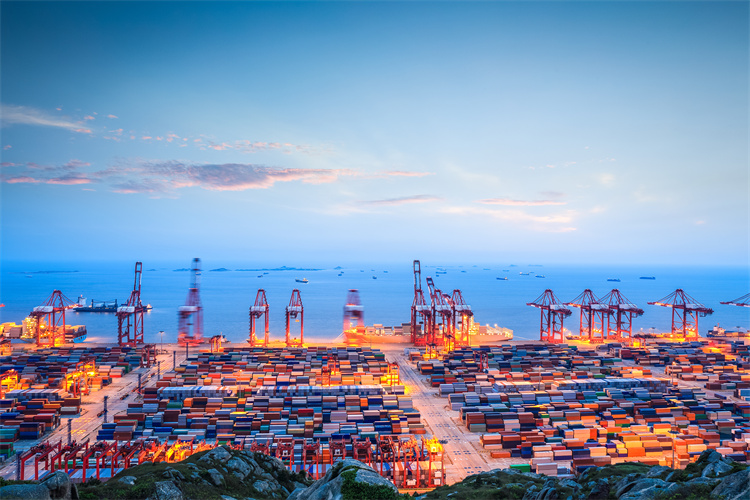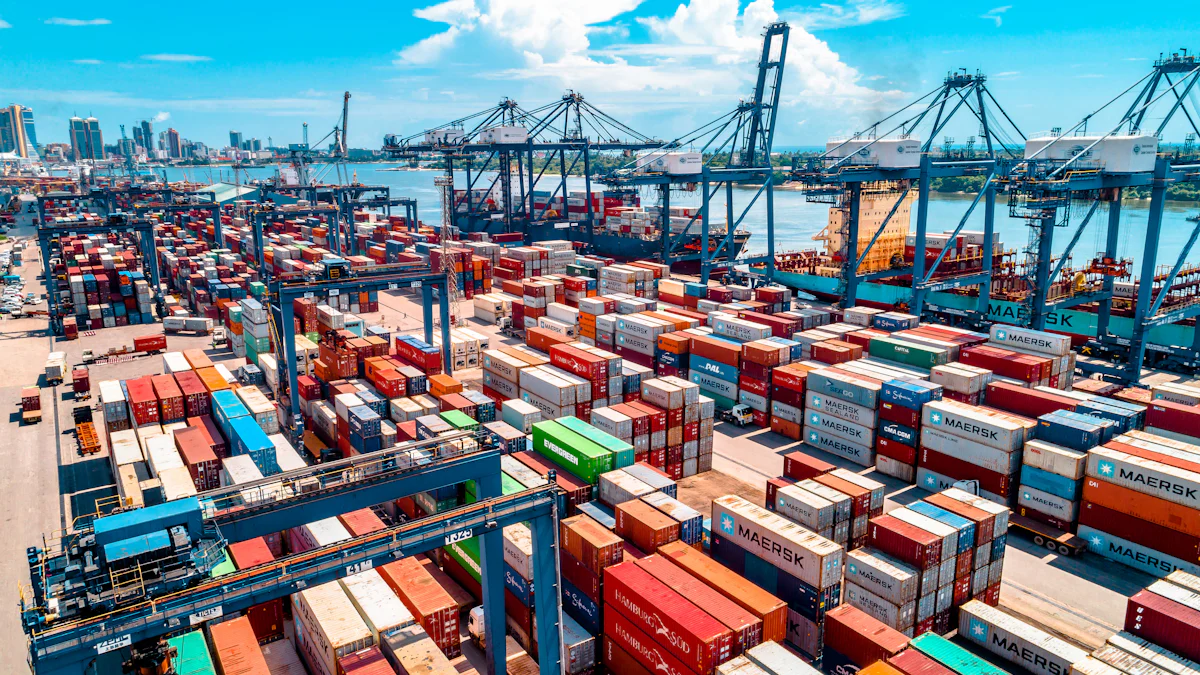2025 Ocean Freight Market Predictions and Insights

The ocean shipping industry is poised for growth in 2025, with container volumes projected to rise by 3-4%. Advanced technologies like artificial intelligence and real-time tracking will transform logistics. Predictive analytics will optimize routes, improving delivery timelines. These advancements will help you navigate the evolving market and meet increasing global trade demands.
Key Takeaways
Container shipping is expected to grow 3-4% in 2025. However, too many containers might keep prices steady.
Use new tools like live tracking and data predictions. These can make shipping faster and cheaper.
Keep up with world events and money changes. This helps you adjust your plans when needed.
Current Ocean Shipping Market Overview
Key Trends from 2023-2024
The ocean shipping industry experienced notable shifts during 2023-2024. Global trade volumes grew unevenly, driven by pent-up demand and easing Federal Reserve policies. Container transport volumes showed steady growth, projected at 3-4% annually despite inflation and geopolitical tensions. Freight rates, however, fluctuated significantly. Spot rates peaked in 2021, exceeding average costs per mile by over $1, but compressed in 2023 as rising costs reduced margins to nearly zero.
Port congestion remained a persistent challenge. Major ports worldwide struggled to handle increased cargo volumes, causing delays and inefficiencies.
Year | Freight Rate Change | Notes |
|---|---|---|
2021 | Peaked | Spot rates exceeded average cost per mile by over $1 |
2023 | Compression | Spot rate margin reduced to nearly zero due to rising costs |
Supply and Demand Dynamics in Recent Years
The ocean freight market has seen a complex interplay of supply and demand. Capacity is expected to increase by 8% in 2025, while demand is projected to rise by only 3%. This imbalance suggests that supply will outpace demand, potentially stabilizing rates. However, disruptions and geopolitical tensions may still complicate the market.
Carriers have expanded services to meet robust demand, leading to higher Peak Season Surcharges. Stability in rates from Asia contrasts with these increases, reflecting the evolving dynamics. Shifting carrier alliances and changing demand patterns further highlight the importance of understanding supply and demand to mitigate risks and optimize costs.
Geopolitical Events and Their Impact on Freight Rates
Geopolitical events significantly influenced freight rates during 2023-2024. December 2023 saw a recovery in rates after a bearish year. However, incidents like the attack on the Galaxy Leader by Houthi rebels posed serious threats to shipping. Companies considered rerouting around the Cape of Good Hope to restore profit margins.
Event Description | Impact on Freight Rates | Affected Regions |
|---|---|---|
Disruptions in the Red Sea | Global, especially SIDS and LDCs | |
Attacks on vessels | Forced rerouting, leading to higher shipping costs | Global supply chains |
These events disrupted global supply chains, increasing operational costs and affecting shipping services worldwide. Understanding these risks is crucial for navigating the ocean freight market effectively.
2025 Ocean Freight Rate Forecast

Supply-Demand Projections for 2025
The ocean freight market in 2025 will face a challenging supply-demand balance. Container volumes are expected to grow by 3-4%, reflecting steady demand for shipping services. However, capacity expansions will outpace this growth, creating an oversupply scenario. This imbalance could stabilize rates but may also lead to increased competition among carriers.
Demand growth for ocean freight is projected at 3-4%, with a conservative estimate of 3% due to current economic conditions.
Capacity is set to increase significantly as new cargo ships enter the market.
High freight rates will persist, driven by the gap between supply and demand.
Understanding these dynamics will help you anticipate market shifts and adjust your logistics strategies effectively.
Economic and Geopolitical Influences on Freight Rates
Economic recovery and geopolitical tensions will shape freight rates in 2025. Inflation remains a critical factor, increasing shipping expenses through rising fuel and raw material costs. Low consumer confidence and higher import tariffs in the U.S. could further strain demand.
Inflationary pressures will drive up operational costs, impacting freight rates.
Uneven global trade recovery will create demand fluctuations across regions.
Geopolitical tensions, including potential port strikes and tariff changes, will disrupt trade routes and add volatility.
Monitoring these factors will allow you to mitigate risks and maintain competitiveness in the evolving ocean shipping landscape.
Rate Fluctuations Across Major Trade Lanes
Freight rates across major trade lanes will experience varying levels of volatility. Key routes like Asia to Europe and Asia to the U.S. will see significant fluctuations due to supply-demand dynamics and ongoing disruptions. In contrast, routes from Europe to the U.S. and Europe to Asia are expected to remain stable.
Blank sailings and operational reliability issues will contribute to rate volatility.
Disruptions like Suez Canal diversions will continue to impact shipping schedules.
Index-linked contracts may offer a way to adapt to these fluctuations, aligning costs with market trends.
By leveraging robust analytics tools and data-driven strategies, you can navigate these rate changes and optimize your shipping operations.
Key Challenges and Opportunities in Ocean Shipping

Managing Capacity and Port Congestion
Managing capacity and port congestion will remain a critical challenge in 2025. Stricter environmental regulations have slowed sailing speeds and increased the demand for cleaner fuels, causing delays in supply chains. Insufficient infrastructure investment has left many ports with outdated facilities, unable to handle growing trade volumes. Labor shortages, driven by an aging workforce and post-pandemic shifts, have further strained port operations. Geopolitical tensions, particularly in the Red Sea, have forced ships to reroute, increasing congestion at alternative ports. Additionally, cybersecurity threats have disrupted port efficiency, leading to operational delays. Addressing these issues requires proactive planning and investment in modern infrastructure and workforce development.
Sustainability and Environmental Regulations
Sustainability initiatives are reshaping ocean shipping operations. The International Maritime Organization’s “Zero by 2050” goal and the EU’s Fit for 55 Package are driving the industry toward decarbonization. For example, ships over 5,000 gross tons must reduce greenhouse gas emissions by 2% by 2025. Companies failing to comply with these regulations risk penalties. However, adopting greener practices offers opportunities to enhance brand reputation and customer loyalty. Leaders in green shipping are already investing in alternative fuels like biofuels and carbon-neutral methanol. These efforts not only reduce emissions but also position businesses as pioneers in sustainable logistics.
Regulation | Description | Timeline |
|---|---|---|
Zero by 2050 Goal | Adoption of a target for zero emissions in global shipping by 2050 | Target set at MEPC79 |
Fit for 55 Package | Requires ships over 5,000 gross tons to reduce GHG emissions by 2% by 2025 | 2025-2050 |
EU Emissions Trading System | Ships over 5,000 gross tons must purchase emissions allowances | Phased in by 2025 |
Technological Advancements in Logistics and Supply Chains
Technological advancements are creating opportunities to address capacity challenges and improve efficiency. Robotics and automation are streamlining cargo handling, reducing human error, and minimizing waiting times. Big data and analytics help identify trends and optimize processes, enabling better decision-making. Autonomous ships are enhancing safety and reducing fuel consumption. Companies integrating predictive analytics have reported up to a 30% improvement in on-time deliveries and a 15% reduction in shipping costs. Additionally, green shipping innovations, such as alternative fuels like LNG and hydrogen, are reducing the industry’s carbon footprint. Embracing these technologies will help you stay competitive in the evolving market.
Leveraging JUSDA’s Solutions for 2025 Ocean Freight
How JUSDA’s Ocean Shipping Services Address Market Needs
JUSDA’s ocean shipping services provide innovative solutions to meet the demands of global trade in 2025. By combining advanced technologies with multimodal logistics options, JUSDA ensures efficient, reliable, and cost-effective operations. The JusLink Intelligent Supply Chain platform and the China-Europe Express Rail are key components of these services. These tools help you manage the complexities of international logistics, offering seamless integration across transportation modes. With JUSDA, you can optimize your supply chain strategies to navigate the challenges of the evolving ocean shipping market.
The Role of China-Europe Express Rail in Supply Chain Optimization
The China-Europe Express Rail offers a faster alternative to sea freight and a more affordable option compared to air freight. This service bridges the gap between speed and cost, delivering goods between China and Europe in just 15-20 days. It supports a wide range of products, including electronics, clothing, and medical supplies. By leveraging JUSDA’s expertise in intercontinental logistics, you can benefit from smooth customs operations and reduced transit times. The rail service also integrates sea-rail intermodal solutions, connecting markets in Japan, South Korea, and Taiwan to Europe. This makes it an ideal choice for optimizing your supply chain in 2025 ocean freight operations.
JusLink Intelligent Supply Chain for Enhanced Visibility and Efficiency
JusLink Intelligent Supply Chain enhances visibility and efficiency in your logistics operations.
Real-time tracking provides constant shipment visibility.
Predictive analytics anticipate rate changes and identify cost-saving opportunities.
IoT, cloud computing, and big data integration offer insights into market trends.
Streamlined operations foster collaboration, reducing inefficiencies.
By integrating JusLink into your shipping services, you gain control over your supply chain, allowing you to resolve issues proactively and adapt to market volatility.
Recommendations for Businesses in 2025
Strategies for Cost Management and Risk Mitigation
Managing costs and mitigating risks in the 2025 ocean freight market requires a proactive approach. You can adopt several strategies to stay competitive:
Diversify rate strategies: Avoid relying solely on fixed-rate agreements. Incorporate floating index-based contracts to adapt to market fluctuations.
Plan for seasonality: Align your shipping schedules with seasonal demand to optimize costs.
Leverage technology: Use advanced tools to streamline shipping processes and reduce expenses.
Tip: Prioritize freight rate analysis to identify cost-saving opportunities and adapt to market changes effectively.
Strategy | Description |
|---|---|
Diversify Shipping Routes | Explore alternative routes to avoid congestion and delays, reducing overall costs. |
Adopt Sustainable Practices | Implement eco-friendly measures to enhance brand reputation and avoid regulatory penalties. |
Stay Agile | Develop contingency plans to address potential disruptions, such as geopolitical tensions. |
By diversifying your carrier alliances and localizing supply chains, you can further reduce risks and enhance operational flexibility.
Leveraging Digital Tools for Operational Efficiency
Digital transformation is revolutionizing ocean freight operations. You can harness these advancements to improve efficiency:
Use real-time tracking to gain visibility across your supply chain.
Replace manual processes with digitized workflows to minimize errors and save time.
Invest in technologies like AI, IoT, and machine learning to optimize operations and ensure compliance with regulations.
Collaborate with stakeholders through cloud-based platforms to enhance communication and coordination.
According to industry reports, businesses that embrace digital tools experience up to a 30% improvement in delivery timelines and a 15% reduction in shipping costs.
By treating freight management as a core competency and investing in skilled logistics professionals, you can boost customer satisfaction and strengthen your brand reputation.
Building Resilient Supply Chains with JUSDA’s Expertise
JUSDA offers comprehensive solutions to help you build resilient supply chains. Its services cover every aspect of supply chain management, including vendor-managed inventory, cross-border logistics, and warehousing. The JusLink Smart Supply Chain Management Platform enhances visibility and control through advanced technologies like IoT and big data.
Note: Localizing supply chains and establishing regional warehouses can reduce reliance on long-distance shipping, minimizing disruptions caused by port congestion or geopolitical issues.
With JUSDA’s expertise, you can achieve seamless integration and operational efficiency. These capabilities enable you to navigate supply chain complexities and maintain a competitive edge in the dynamic ocean freight market.

JUSDA Solutions
To provide you with professional solutions and quotations.
The 2025 shipping market will evolve with fluctuating rates, technological advancements, and shifting trade policies. You must stay agile by diversifying routes, adopting real-time tracking, and investing in greener technologies. Predictions indicate container volumes will grow, but geopolitical shifts may disrupt freight market trends. Staying informed ensures your success in this dynamic landscape.
See Also
Discovering Innovations in Sea Freight Logistics for 2024
In-Depth Look at the Future of LTL Freight
Five Key Trends Shaping Future Supply Chain Efficiency
Understanding Current Trends in Logistics Risk Management
Getting Prepared: New Transport Technologies for Supply Chains
